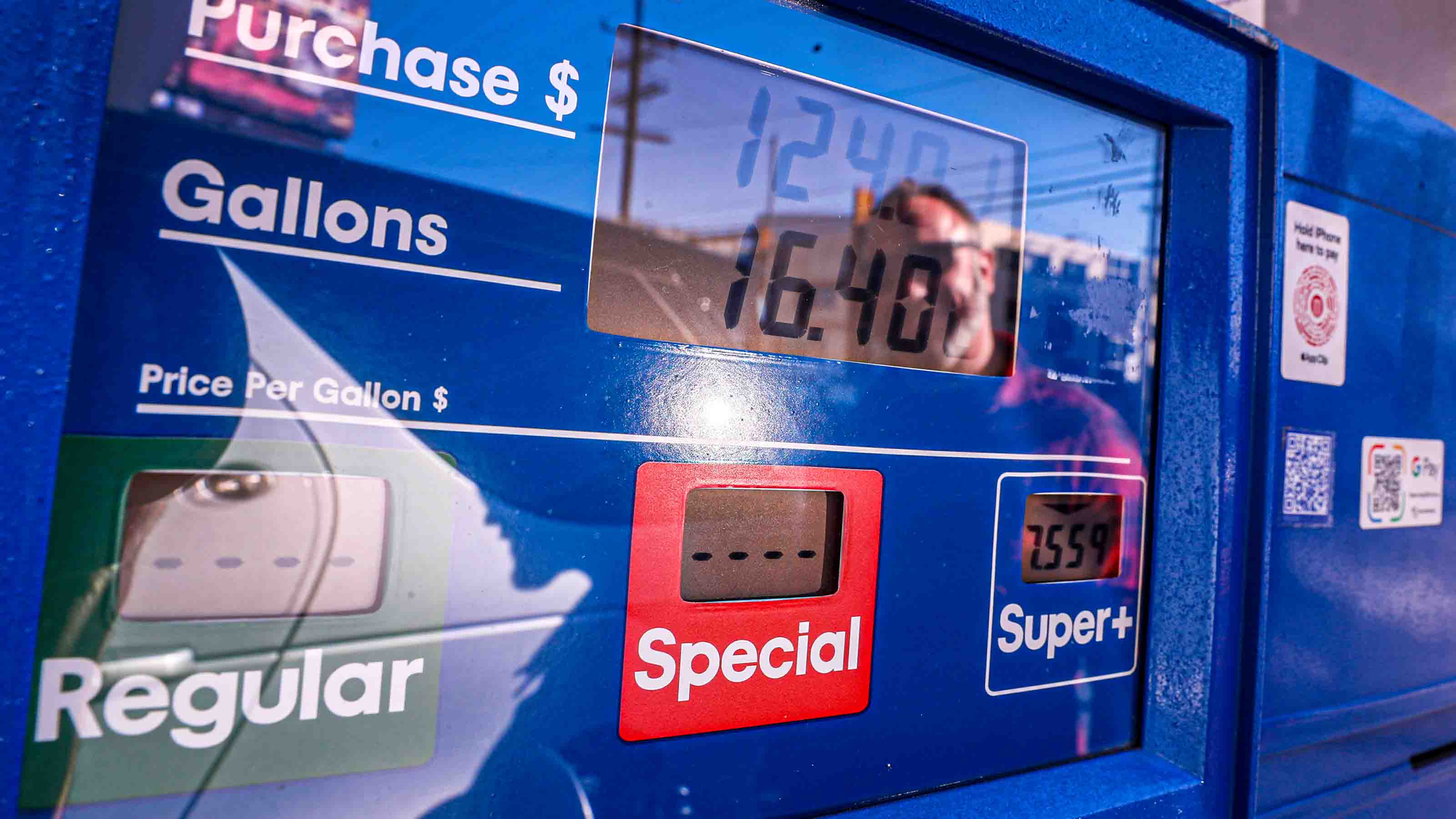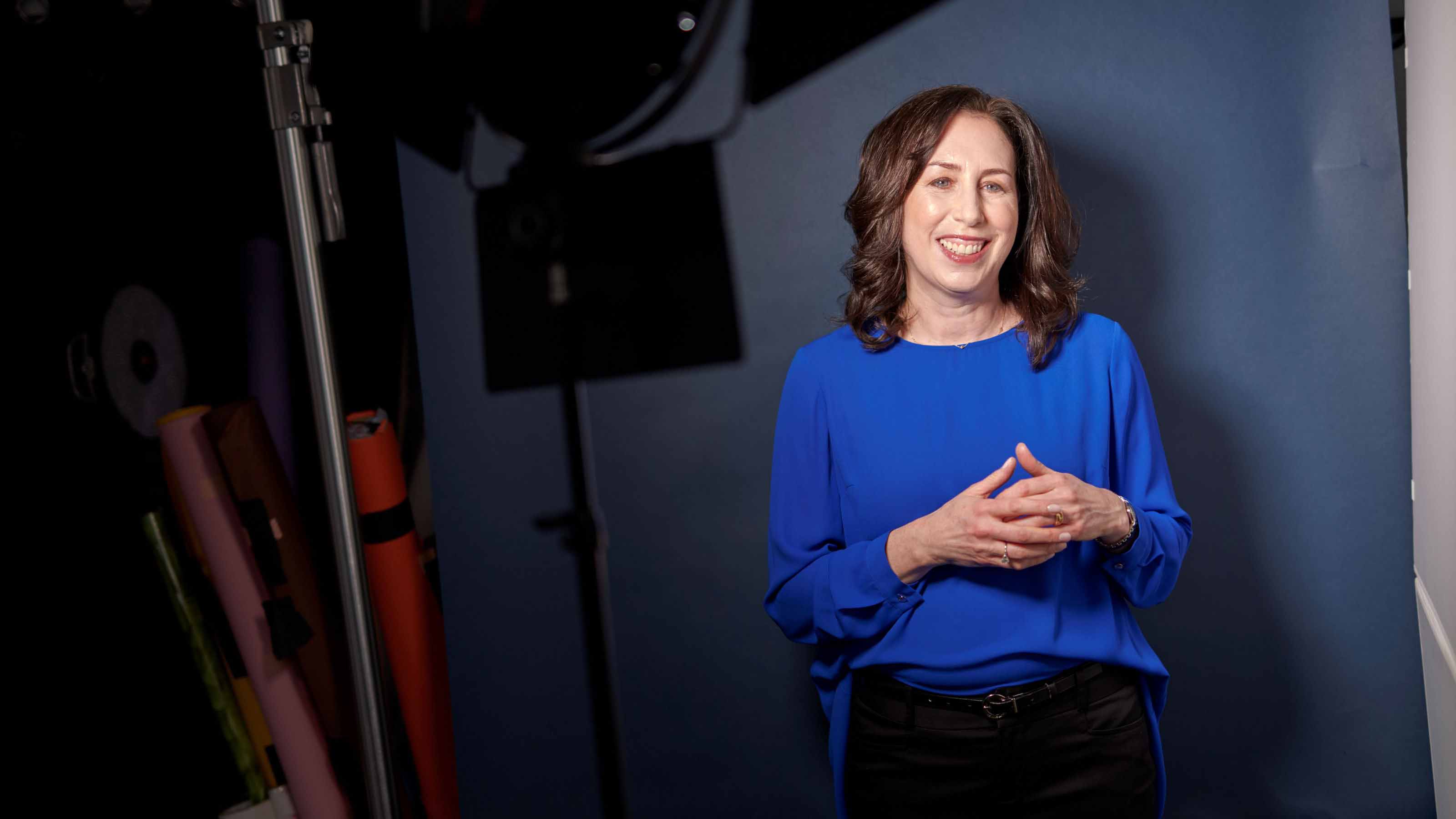PODCAST: Car-Buying in an Inflated Market with Jenni Newman
With cars both scarce and expensive these days, what to do if you want – or need – a new ride? Car-buying strategist Jenni Newman of Cars.com shares some tips. Also, more on the magical 9% savings bond.

Subscribe FREE wherever you listen:
Apple Podcasts | Google Podcasts | Spotify | Overcast | RSS
Links mentioned in this episode:
- Kiplinger’s Economic Outlooks: Inflation
- Fight Inflation with Series I Bonds
- TreasuryDirect: Buying Series I Savings Bonds
- Cars.com: Buckle Up With Jenni Newman, our Editor-in-Chief
- Electric Vehicles Take Charge in 2022
- Cars.com: Your Guide to EV Batteries
Transcript:
David Muhlbaum: Cars are expensive these days. In fact, they’ve been on the leading edge of the inflation surge that’s paining the U.S. economy. Maybe you’re trying to wait it out, hoping that prices will eventually fall, but maybe you don’t have a choice and need a car now. Jenni Newman of Cars.com joins us to talk about what you could expect to pay and how the way we buy cars is changing. Also, we’ll come back to the suddenly sexy US savings bond, all coming up on this episode of Your Money’s Worth.

Sign up for Kiplinger’s Free E-Newsletters
Profit and prosper with the best of expert advice on investing, taxes, retirement, personal finance and more - straight to your e-mail.
Profit and prosper with the best of expert advice - straight to your e-mail.
David Muhlbaum: Welcome to Your Money’s Worth. I’m kiplinger.com senior online editor David Muhlbaum, joined by my co-host, senior editor, Sandy Block. How are you doing Sandy?
Sandy Block: I’m doing great.
David Muhlbaum: Good. A few episodes back here, we were discussing Series I savings bonds — again — and I made a vague promise to actually buy one. And I am proud to report that I have done so. I just checked the account and I now have an investment backed by the full faith of the US government and it pays a 9.62% coupon. Well, for now it does.
Sandy Block: Yeah. That ‘for now’ is one of the catches and I’m sure you’re aware of that.
David Muhlbaum: Yes, I do. But actually, I do want you to enumerate all the other catches to my very smart purchase. We’ll get to those, but that 9.62% interest rate, that’s pretty insane. You’re not going to get that anywhere else these days, no matter how hard Jerome Powell and his friends yank on the brakes with rate hikes.
Sandy Block: No, that’s right. In fact, I was reading an article today sort-of celebrating the fact that some banks are now paying more than 1% interest on savings accounts. There’s nothing even remotely close to that unless you’re going out and taking a huge amount of risk. It’s just really unprecedented. And I’ve written about savings bonds for a long, long time.
David Muhlbaum: When they were boring.
Sandy Block: When they were very boring. That’s right. I just don’t think the government, when they created I bonds, ever anticipated that it would be paying out 9% interest.
David Muhlbaum: Yeah. Well that does raise some questions about the long-term viability of this, that I’d like to get to. But in the meantime, I thought, well, to pat myself on the back, I was doing a little bit of service journalism there because I know the website at TreasuryDirect has been crashed because of the interest in the I bonds. Apparently, it’s extremely hard to get anyone on the phone to talk about it. So I thought I would put my money where my mouth is and well, a little bit of it, and go through the process of buying one. And so the report is, it was a little nerve wracking, but I wouldn’t describe it as out of the ordinary for A) a government site and B) moving money. You’re expecting to have a higher degree of standards and using a good password and being sent to some secondary form of checking. I did note though, that it all seems it’s going to turn on your Social Security number. And I think, Sandy, you said that that could cause problems, at least, it had for you.
Sandy Block: Well yeah. And just to back up a little bit, I think where we’re hearing problems is if you have a problem, there is no one... Where people are running into problems is, they put in the wrong bank account or have a question or something, and there’s no one there to answer their questions. What I discovered, I’ve had a TreasuryDirect account for years, which I haven’t used. And when I went on to look and see if I could find my account number, I realized in order to get my account number, I have to put in a whole bunch of information, including the name of the bank that I had when I set up the TreasuryDirect account over 10 years ago and I don’t have that bank account anymore. And there doesn’t seem to be any way to fix that problem.
Sandy Block: And that’s the kind of thing that people are running into. If they want to change banks, maybe they put in a wrong account number or something like that, there really is no one there. And in fact, if you go onto TreasuryDirect right now, there’s a little box mentioning the high volume of activity and reminding people that they have until October to buy an I bond at this rate, so it’s almost like they’re telling people, please, please come back because we are really, really busy now.
David Muhlbaum: Now, okay, that’s an interesting point that you bring up the date. They have until October to buy the I bond at this rate. Let’s get into the nitty gritty about how the I bond works because there is a rate reset every six months. A portion of the interest rate gets reset, and that’s why it’s so stinking high right now.
Sandy Block: Right. Right. And I think if you somehow don’t buy one by October, I think given what we know about the inflation rate and where things are going, I think that the next six months, they’re probably going to be pretty generous too. But here’s the catch, I bonds consists of two components, a fixed rate that you get for the life of the bond and an inflation rate is set every six months. Right now, the fixed rate is zero. So if you buy an I bond now and inflation goes away, they won’t pay a negative rate, but you could end up with a very, very low rate I bond closer to a savings account. Now, at these rates, I think that’s a risk worth taking. You have to hold an I bond for at least a year. You’re required to hold it for at least a year, so this isn’t something you want to buy if you need the money soon. And if you cash it out in five years, you give up the past three months of interest. At this rate, that’s not that bad. You’d still come out ahead if you cash it out in five years, but you need to know these things about the liquidity of these bonds and the other-
David Muhlbaum: The term, too. The term is like 30 years or something.
Sandy Block: Yeah. The term, sure .. but you’re required to hold it for five years. You can redeem it after that. The other thing, and we’ve had a interesting conversation within our investing team about a limitation of the I bond is how much you can invest. The maximum you can put in an I bond is $10,000. That’s the electronic limit. If you happen to get a nice tax refund, you can use an additional $5,000 to buy a paper I bond, but that’s it. So this is-
David Muhlbaum: Yeah. Now that’s getting so arcane because you have to then cook your withholdings to get a refund so you can buy a paper bond. I’m like, oh my god, this is truly some sort of Washingtonian hell.
Sandy Block: Well, I think that was slipped into some bill to encourage people to save or something like that. But the $10,000 cutoff means that you’re not going to put your entire retirement savings in an I bond. For an emergency fund that you might need in a couple of years or something that you just want to put some money away, maybe as a down payment on a house you’re going to buy, well, $10,000 won’t get you very far, but part of a down payment or a car that you’re going to buy in a few years, I think a savings bond, an I bond, is a perfectly good use for that money. But it’s not as liquid as a savings account, and it’s not as generous as say a 401(k) or an IRA where you can put a lot more money in.
David Muhlbaum: Well, in terms of how much you can invest in.
Sandy Block: In terms of the amount that you can invest.
David Muhlbaum: But in terms of what it’s paying right now...
Sandy Block: In terms of what it’s paying right now, there is nothing out there.
David Muhlbaum: And I think, if my understanding is correct, part of the reason for those limits, the $10,000 and maybe $15,000 limit is in part because of this sort of fundamental generosity or potential generosity of the program. And it got me to thinking that the limit is not higher than that because if everybody started throwing big money at this, it would become, or it would become even more of potentially a federal subsidy. As you said, the people who created the I bond did not expect to be paying a 9.62% coupon. And there are real questions. How long can this last? By last, I don’t mean interest rates. How long will this program last?
Sandy Block: Well, and that’s a good question, Dave, because it’s been a few years, but I used to write a lot about savings bonds. And my understanding is even when interest rates were very low, the cost of administering this program exceeds the amount that the government takes in. The green-eyeshade folks at the government have wanted to get rid of savings bonds for years. It does not make money for the US government, but people love savings bonds.
David Muhlbaum: Yeah, I think Franklin Roosevelt bought the first one, right?
Sandy Block: Yes, people have this, the war bonds. People have this very emotional-
David Muhlbaum: Sentimental attachment.
Sandy Block: ... connection. They like to give them to their kids or their grandkids. So I don’t think savings bonds are going anywhere, but the $10,000 cutoff and eliminating paper bonds a few years ago were all steps in the direction of discouraging people from buying savings bonds. Because the government really, apparently, it is just a hassle to administer. You think about where the government does most of its borrowing. It’s with huge banks and financial services firms that take out enormous amounts of government debt. We’re talking, these are small amounts and lots and lots of people. And I think deep down, Treasury would really not like to deal with that, but they’re dealing with it now in a very big way.
David Muhlbaum: Yeah. In terms of those amounts, I tried poking around at the numbers here and I didn’t get to the specificity that I was hoping for, but I do know that like in 2020, the number of these I bonds being sold was in the millions, in the millions of dollars of I bonds being sold.
Sandy Block: Yeah.
David Muhlbaum: Now, it’s in the billions.
Sandy Block: Oh, I’m sure it is.
David Muhlbaum: And now, I know that that is just a drop in the bucket, in the complete realm of federal borrowing, but as a percentage change in this one program, it’s certainly proved to be popular.
Sandy Block: Yes it has. And will continue, I think, as long as inflation remains elevated.
David Muhlbaum: Yes. And that is our forecast as well. And I will pop in a link to our inflation forecast so you can read it and weep, or at least be informed. And also, I’ll put in some information about how to actually buy an I bond if you want to follow my path and go get your 9.62% – for now – coupon. Coming up next, we are going to talk about car buying in this overpriced market with Jenni Newman, the executive editor of Cars.com. Stick around
Car-Buying in an Inflated Market with Jenni Newman
David Muhlbaum: Welcome back to Your Money’s Worth. For this segment. I’ll be joined by the editor of Kiplinger’s Personal Finance magazine himself, Mark Solheim. A voice you’ve heard on the podcast before when the topic is cars. And that indeed is what we’re going to cover today. How to buy a car for a reasonable price as we enter the third year of a rather different and difficult market. Joining us to sort that out and talk about four wheels in general is Jenni Newman, editor in chief of the web site Cars.com. Welcome Jenni.
Jenni Newman: Hi, thanks for having me.
David Muhlbaum: Part of the beauty of Cars.com is that domain name. Whoever it was, 25 years or so ago, who thought to grab that domain was a genius because it’s so self-explanatory. I just had to say, you’re the editor of Cars.com and people know, okay, you know cars. But I would like you to take a moment to explain to people what Cars.com is and how you fit in because like some other automotive websites we’ve mentioned at Kiplinger or used as resources, you guys could be multiple things to different constituencies, dealers, consumers, journalists, podcast hosts.
Jenni Newman: Yes. Whoever picked out Cars.com did indeed choose wisely. So Cars.com is the leading automotive marketplace. What that means is we connect car shoppers with car dealers. And what I really, of course here’s my own bias, like to talk about is the editorial content that is available on cars.com. We have a seasoned editorial team, independent journalists that provide news coverage, reviews of vehicles, of course, as well as videos. And we’re basically here to help car shoppers do the homework. We know that buying a car is quite a journey and we want to help them find the car that’s best for them. That’s our goal.
Mark Solheim: So Jenni, I spent a little bit of time in the car journalist game, I guess. Reviewed cars for Kiplinger 15, 20 years ago. And I know from back then that this is a very testosterone-heavy industry. You talk about car guys and I suppose you talk about car girls, but I know there weren’t that many women around. So I’m curious how you broke into this industry. I also noticed from your bio that you’re very modest about your credentials and you do play up your role as a mom and as a car-seat tester. So I’m just curious how all that evolved before we get into some sound consumer advice here.
Jenni Newman: Sure. I started at Cars.com almost 14 years ago as a copy editor. And before that, I was in newspapers. So that’s another male-dominated industry. What I found at cars was a mission to help consumers. I think it was an early version of service journalism, to be honest with you. And it really spoke to me. I’ve always had a love of cars. I would not call myself a gearhead at all, but I find it fascinating. It’s always changing. And so I’m always just interested and always learning. And that’s what keeps me engaged. As far as our approach, we really do just want to help the shoppers and yes, I’m a mom of two boys.
David Muhlbaum: Cool. Hopefully we’re done with the grilling, such as it is. Let’s talk cars writ large, not cars.com. Now we at Kiplinger, we also have a mission statement of sorts. It’s right there in the name, at least the magazine Kiplinger’s Personal Finance. And the personal finance part means that at least when it comes to cars, we are more about the cost question, acquisition, financing, maintenance, insurance, that sort of thing than shall we say the experience? 0 to 60, miles per gallon, how many cup holders, how much range?
David Muhlbaum: So, two years ago or so, we thought we had a decent sense of how to buy a car and we tried to share that with our readers; shopping tips, how to negotiate, financing guidelines. Yeah. It sounds like what Cars.com does. But all of that has been deeply challenged during the pandemic. Or maybe I should say during the chip shortage? It’s hard to pry the two apart, but they both seem to be sticking with us. So big question, are we ever going to get back to a more normal car market where a new car isn’t something that a consumer has to scour the country for and possibly pay this hated additional dealer markup for?
Jenni Newman: Good question. Car shopping has definitely evolved during the pandemic. We saw a lot of dealers on Cars.com quickly pivot from a traditional car buying selling experience to a more online experience. And that was a really quick move that they had to make during those early months of the pandemic. That really ushered in more comfortability for shoppers, with online searching and even the online buying process. Seeing that translate from, “Oh, I’m going to buy something on Amazon” to, “Oh my gosh, I’m going to order a car online”. We’re seeing shoppers easily flow between these small purchases and massive purchases now these days.
Now, as far as getting back to normal, I don’t have a crystal ball. I don’t know anybody who does, but what I will tell you is I’m not sure we’re ever going to fully get back to normal. There has been so much evolution in the way that car shoppers are working these days, the way that dealers are working these days, that I think that we’re starting to see the path forward come together. Shoppers have become more comfortable with ordering vehicles when they can’t find what they’re looking for. We know that for instance, Volvo is pivoting to selling their EVs online only. And they’re going to be selling EVs only by 2030. So we’re already seeing some automakers shifting.
Of course, we know that Tesla is also an online buying opportunity. And then when it comes to more of the dealership side of things, what we’re seeing is of course, right now, when you drive by a dealership, there are fewer cars on the lot. There’s a lot of wasted real estate. And so I wouldn’t be surprised to see automakers and dealerships rethink the way that they use that real estate, whether it’s the building or whether it’s their lots, and perhaps scale back because they simply don’t have as many cars sitting around. So I think we’ll be onto a new normal as they say. I don’t think we’ll ever quite go back to what it was.
Mark Solheim: Is part of that new normal... You’re paying list price. And you talk about Tesla, there’s no negotiation with the Tesla. And more and more people these days I know are paying MSRP or a markup. Do you see that happening as well? And what does the consumer do now? There’s no longer negotiating over invoice. Now you’re paying MSRP, I guess.
Jenni Newman: Yes. It’s a really interesting market right now because there really isn’t a lot of room for negotiation if you want that vehicle. So I think that’s the big question. As a shopper, if you have time on your side and you don’t need to have that vehicle immediately, then you have a little more flexibility, a little more wiggle room. And perhaps you try to wait out some of the constrictions on the car market right now. But you could be waiting a long time.
We’re two years into this. We’re already in year three. It’s not easing up as quickly as anybody would’ve liked, so there’s that to consider. And I know that some of my colleagues consider that markup the price of doing business right now when it comes to car buying, I recently purchased a personal vehicle and paid a bit of a markup on it. And that was something I had to think through. But ultimately, I knew what car I wanted and I knew the timeline I wanted to get it in. And so in my mind, that was the price I had to pay to get that vehicle on my timeline.
David Muhlbaum: Literally the price you had to pay, yeah. Your answer earlier about all the macro factors like real estate that come into play with the existing dealership model are fascinating. I can go in so many tangents about that. One of the ones that came to mind is that the whole model before where a dealer would buy or order a whole bunch of cars and then hold onto inventory in hopes of selling it, was fundamentally inefficient now. My understanding is that they enjoyed backed up financing and incentives from the factory to support that model.
David Muhlbaum: But fundamentally, it does seem a whole lot cleaner to order or nail down what you want and get it. The sticking point of course, is that price. So we have this weird confabulation, to use a fancy word, of both this online evolution, which I think consumers were clamoring for, and literal sticker shock when people still have to go look at the piece of paper on the window and then, scribbled down in Sharpie at the bottom, it says, “and another $5,000”. The additional dealer markup. It’s weird because you both had this forward-looking approach of bringing it online and making it smooth and this like, “wait, what?” encounter when people actually see that they’re going to have to pay more, not for anything they’re getting, but except for the car.
Jenni Newman: Right. For the ability to get a car now. Yeah. And perhaps that will change and ease up a little bit as we see the new car inventory grow. I can share that in April of 2022, year over year, new car inventory was down 51%. We know that new car inventory has been hit so hard. And so as we see more new cars come into the marketplace, perhaps that $5,000 additional charge is cut in half. And then perhaps it’s cut down some more and then eventually it fades away as more competition comes back into car shopping. But for right now, paying $5,000 extra, that’s a little steep, that feels a little steep, but it’s not unusual right now.
Mark Solheim: May I ask what car you recently bought, Jenni?
Jenni Newman: Of course. I recently bought a Hyundai IONIQ 5. So we purchased an EV and we paid... I’ll be really transparent. We paid $2,500 over the price. So we definitely paid for it.
Mark Solheim: A real bargain. Yeah.
David Muhlbaum: That’s a cool car though. That’s one of the cars we included in our EV roundup. And I love the styling of that with the... It’s the sort of the Atari vehicle, right?
Jenni Newman: It is. We definitely get a lot of looks when we’re driving it around the city here in Chicago.
Mark Solheim: And you were able to pull the trigger on an EV because I assume this is mainly around town in a vehicle, not long cross-country trips or...?
Jenni Newman: So, we will use it mainly around town, but we are intending to do a couple road trips in it this summer and see how it does. At cars.com, we own a Tesla model Y and have been putting that to the test, not only as an around town vehicle, but also again for road tripping, just in all the ways that you use a vehicle. And so I’m really curious to see how my personal EV, the IONIQ 5, compares to the ease of which the model Y and the Tesla system already has set up as far as infrastructure. So, yeah. Basically my family will be living an experiment with me so it should be a lot of fun
David Muhlbaum: Since we’ve broached electrics, I just want to basically throw out a kudo to Cars.com and I’ll put in a link to this article. You guys had a really interesting piece about the long-term dynamics of electric vehicle ownership when it comes to battery life and battery performance, which is one of those bugbears. It always gets floated up when we talk about EVs, like, “Is the battery going to last?” And I’ve found it really informative. And so I’ll pop in a link for that because I know we’ve talked EVs before on this podcast, and I always get feedback. This is a good one to read.
Jenni Newman: Thank you so much. And I’ll say that we’ve been building out just a library of EV content, because there’s so much for consumers to learn around EV ownership, around battery, around range anxiety. There’s so much to take in. And so we want to help shoppers, as I mentioned, find the car that’s right for them, whether that’s an EV or whether that’s a traditional gas powered vehicle. So that’s our goal there.
Mark Solheim: Or a hybrid.
Jenni Newman: Or a hybrid.
David Muhlbaum: Or in between. Going back to pricing and the higher prices that people are paying for new cars and for used cars. Now there’s a flip side to this for the consumer too. Most people don’t own more cars than they need, and if they’re going to buy one, they’re going to sell one. And so those higher values should also translate into better trade-in offer from dealers. So I’m wondering what should someone do to make sure they’re getting the best deal on their trade-in in this market? Have the rules changed there?
Jenni Newman: I don’t know if the rules have changed, but I think there needs to be some education around what people should do. And really that is just put in the work to find the best offer. So that means, just like when you used to negotiate on a car price for a car that you were buying, when it comes to trading in or selling your vehicle, you want to shop around a little bit. Take some time. Get offers from various dealerships, whether they’re national brands, whether they’re your local brand, definitely visit the automaker of the vehicle that you own and see what kind of offers you can get and get it in writing, of course, so that you can then take those offers and play them off each other, and perhaps get an even higher price than you would’ve in the past.
Jenni Newman: Earlier, as we started to see used car prices increase, I actually had an extra vehicle. Don’t ask me how it happened, but I had an extra vehicle and I ended up selling it for about 50% more than I would’ve gotten had I sold it earlier. And so I was pleasantly surprised by that. I do kick myself for maybe being a little bit ahead of the curve when it comes to car prices, but it’s definitely worth putting in the time. It did take me about a week to get all those offers in and to make a decision though. So, it’s some work.
David Muhlbaum: That question of timing and doing it is what I like to call carbitrage. And it’s a tough game to play, but it sounds like it went well for you. With these values and these ongoing higher values in used car prices and for what people are paying for new cars, I’m wondering what the downside risk is to someone who’s paid that additional markup or paid what they had to pay to get that car now. They could be underwater if some sort of correction comes around. What does that really mean?
Jenni Newman: It’s a good question. I think it’s important to know that... If you’re concerned about this risk, then perhaps this is not the best time for you to be buying a car. We’re seeing higher interest rates, we’re seeing loan lengths grow. And so, if you can hold off on purchasing right now, and you’re not willing to take on this risk, then I would pull back a little. One thing to consider, of course, I think a lot of people tend to shop by monthly payment when they’re purchasing a car, when they’re thinking about how that’s going to impact their budget. One of the things that we like to advise consumers on is that you really should look at the out-the-door price. And so, when you’re talking to a dealer, whether you’re buying a new or a used car, you want to find out what that price is going to be for you to walk up the door, including taxes, fees, license. Any sort of question that any fee that can be added in, you want to know what that number is.
And from there, that’s where you need to... Normally, you’d start your negotiation. Truthfully, these days, that’s probably the price. But then if you’re looking at financing, we see loan lengths now that are 72 months, that are 84 months. You are increasing the length of time that you could be underwater. And so I know it can be a little bit rough, but if you want to shorten your loan, that might help you a little bit on the depreciation front.
Mark Solheim: As we’ve often said at Kiplinger’s, shop around for your financing too. Shop with your local bank, your credit union, as well as a dealer. And if you don’t qualify for the best rates from the dealer, from the manufacturer, those dealers do have lots of options. They’ll set you up. It may not be the cheapest, but you’ll get a loan, no doubt.
Jenni Newman: You will get a loan. And I think for people who have financial means, it’s a little easier these days. It’s a little easier to absorb the increases in interest rates and in inflation, where this tends to herd, of course, is shoppers whose budgets are limited. And you couple that with the increases in car prices, both on the new and used side. This can be a tough market for some shoppers.
David Muhlbaum: Yeah. I just come back to the idea of that we, you, we, others have been saying, wait, wait, wait. But you know, sometimes you need a car. Sometimes the tree fell on it and you need another car. There’s no choice in the matter.
Mark Solheim: So, what would you say then if, say, I’m telling you, Jenni, I need a new car right now. Is it no longer an advantage to looking for a sedan versus an SUV? Am I just stuck?
Jenni Newman: I think unfortunately, a year ago, we would’ve counseled you to maybe go look at sedans, to look at vehicles that are a little less popular. These days, you could be a bit stuck. I think if you are car shopping, it is all about being flexible and being ready. So you want to make sure that you have your financing sorted. You want to make sure that you know exactly what you’re looking for. And then when you can’t find it and you probably can’t, you’ve got some options. You’ve got a couple plans. You’ve got B, C, D E F of vehicles or trim levels that you’re willing to consider. So figure out what are your must-haves and where are you flexible? The car that I purchased, I did not get the color I wanted. And you know what, it’s fine. It’s fine. And that, for us, that was something we were willing to be flexible on. And so, that would be one area I would tell people like color, you’ll get used to it.
Mark Solheim: You’re driving a bright orange car around. That’s okay.
Jenni Newman: Not quite orange, but...
David Muhlbaum: They’ll see you coming. One of the potential advantages of ordering is though to have the color you want, the options you want, the car built the way you want. This mass customization could break for you, but I presume you still have to pay for the privilege.
Jenni Newman: So when it comes to ordering a car, it is the way to get what you want. If you don’t want to be flexible on anything from trim level or features or the color, then ordering is the way to go. Now, depending on the auto maker, you will likely have to put down a deposit which could just be a couple hundred dollars to create the order. And then as we get closer to the build, it could be a little bit more money to lock it in. One thing that we’re finding is of course, with various automakers, depending on what you order, the length of time to get that car in varies. If you are ordering a really specialized vehicle that not a lot of people are ordering, you might be low on the list to get it. Whereas if you managed to order a vehicle that is a volume seller, you could see that quickly. So you need to realize that ordering the vehicle means you’re probably going to wait and with all things, your wait time may vary. So just flexibility is the key.
David Muhlbaum: “Please hold the line; your wait time may vary.” I just wonder and I see anecdotally on social media and other places, stories, anecdotes about just bad dealership experiences. And car dealers were, of course never always that high on people’s lists of places they wanted to go. But the leverage that the current pricing situation seems to have given to dealers has made for stories of bad experiences. And I wonder if that will linger when/if things turn around. Are you hearing any of that sort of story from the front lines?
Jenni Newman: No. I haven’t heard many stories like that, to be honest with you. What I would tell any shopper who’s dissatisfied with the experience they’re receiving with the dealership is you can walk away. And I know it’s hard to do, especially in this market. Perhaps you finally found the vehicle you wanted, but you’re not happy with the way that the conversation is going or even worse, the way you’re being treated. Ultimately, you can walk away and you do not have to give them your business.
Jenni Newman: But what I will tell you is, a lot of dealerships these days, I think that they’re aware of that reputation and they work hard to counter it. And so, this is a Yelp world in a way, and so we know that people are very vocal with their reviews of dealers and even sales people. And in fact, on cars.com, we have ratings of dealerships as well as specific sales people. And so ultimately, it is customer service and it behooves them to treat their customers well, and there are ways to provide feedback should it go well or should it not.
Mark Solheim: I think that the fact that people hate to haggle. We know that people really, except a few individuals with exceptional gifts just are afraid to haggle. And in the past, with a dealer, you’re going for a lower price, the dealer always has the advantage. I’m just guessing that maybe there’s less conflict now that you know you’re paying MSRP or in an additional markup. So maybe that’s eased some of the tension, just a theory.
Jenni Newman: I think that’s a good theory and yes, haggling, Ugh. It’s kind of the worst then I think that sometimes it really, it turns a lot of shoppers off. It adds a lot of tension. I will say that thanks to technology, there are easier ways to haggle when we get back to being able to haggle. You can do it over email; you can do it over text message. There are chats, live chats that you can do. And so you can go back and forth. And if you are haggling, just know that you are going to need to get that offer in some sort of writing. You’re going to need to have a screenshot of it, a PDF of it, something like that to show where everybody landed. But here’s a version of life where haggling gets a little easier when you don’t have to maybe do it face to face.
Mark Solheim: I was just wondering what the landscape for leasing versus buying looks like these days. We have a lot of readers and a lot of podcast listeners that do like to lease.
Jenni Newman: So right now, leasing, you might not find the lowest monthly payment because of the inventory shortage. There’s been drops in incentives. There is higher monthly payments because of the supply crunch. And so we’re seeing not as many people turn to leasing right now, or at least taking a pause.
David Muhlbaum: We keep coming back to this market environment of high prices and ongoing demand and ongoing chip shortages. One of the things I remember driving that in the beginning of the pandemic was people who didn’t have a car or maybe only had one car deciding, “I need a car. I need a car in my life”. I would’ve thought A) That that would’ve been finite. They got their car. They don’t need a third car. And B) I was thinking, do you think those people have regrets at this point? And would that possibly, I’m really speculating here, lead to some of those cars coming back onto the market?
Jenni Newman: Great question about regrets. I do wonder about that as well, simply because we know that the cost of ownership includes things like insurance. And if you’re in big cities, perhaps paying for parking. And then right now, really high gas prices. So cost of ownership could be getting to a point where for some people who stretched their budget to afford a car, perhaps it’s a bit much these days. And with comfort levels increasing during the pandemic, they could be looking to offload their vehicle and if they are, then they will get a really good price for it right now.
Jenni Newman: As far as the number of people during the pandemic who needed new vehicles or who rushed to buy vehicles, I think that so many people have been putting off the purchase of a vehicle because of the constraints in the market that it’s going to be a while before we see things level off from a buying perspective. I do wonder, as automakers continue to slowly, slowly ramp up their new car inventory, how long will it take for us to finally see this crunch of demand level out a bit. So I’m also watching that with a lot of curiosity.
David Muhlbaum: Well, thank you for your insights on that. And for dealing with my complicated two part questions. This demand question is both interesting to explore at a macroeconomic level and really comes home when the tree falls on your car and you need one. So thank you, Jenni, for your insights on helping people get their four wheels, whatever they have to pay for it. Thanks again.
Jenni Newman: Thank you so much for having me today.
Mark Solheim: Jenni, thank you very much. It was a pleasure.
David Muhlbaum: That will just about do it for this episode of Your Money’s Worth. If you like what you heard, please sign up for more at Apple podcasts or wherever you get your content. When you do, please give us a rating and a review. And if you’ve already subscribed, thanks. Please go back and add a rating or review, if you haven’t already. To see the links we’ve mentioned in our show, along with other great Kiplinger content on the topics we’ve discussed, go to kiplinger.com/podcast. The episodes, transcripts, and links are all in there by date. And if you’re still here because you want to give us a piece of your mind, you can stay connected with us on Twitter, Facebook, Instagram, or by emailing us directly at podcast@kiplinger.com. Thanks for listening.
Get Kiplinger Today newsletter — free
Profit and prosper with the best of Kiplinger's advice on investing, taxes, retirement, personal finance and much more. Delivered daily. Enter your email in the box and click Sign Me Up.

Block joined Kiplinger in June 2012 from USA Today, where she was a reporter and personal finance columnist for more than 15 years. Prior to that, she worked for the Akron Beacon-Journal and Dow Jones Newswires. In 1993, she was a Knight-Bagehot fellow in economics and business journalism at the Columbia University Graduate School of Journalism. She has a BA in communications from Bethany College in Bethany, W.Va.
-
 Designing Your 'Immortal' Financial Plan
Designing Your 'Immortal' Financial PlanExplore an approach that offers solutions for those navigating the intersection of longevity, fulfillment and financial security.
By Dennis McNamara
-
 How to Protect Your Privacy While Using AI
How to Protect Your Privacy While Using AIHow to keep your information and finances safe while using AI, including ChatGPT and Perplexity.
By Bob Haegele
-
 Gas-Saving Tips That Actually Work
Gas-Saving Tips That Actually WorkThese are gas-saving tips that will actually work for you and your car this year.
By David Muhlbaum
-
 Want to Lease an EV? The Tax Credit 'Loophole' for That Could Go Away Soon
Want to Lease an EV? The Tax Credit 'Loophole' for That Could Go Away SoonTax Credits If you are deciding whether to lease or buy a car, here's what you need to know about the EV lease tax credit.
By Kelley R. Taylor
-
 Car Buying in a Topsy-Turvy Market
Car Buying in a Topsy-Turvy MarketYou need a new car? Good luck with that! What should you do? We've got some answers.
By Katherine Reynolds Lewis
-
 Watch Out for Flood-Damaged Cars from Hurricane Ian
Watch Out for Flood-Damaged Cars from Hurricane IanBuying & Leasing a Car In the wake of Hurricane Ian, more flood-damaged cars may hit the market. Car prices may rise further because of increased demand as well.
By Bob Niedt
-
 Car Buyers: The 3-Day Grace Period Is Just a Myth!
Car Buyers: The 3-Day Grace Period Is Just a Myth!Buying & Leasing a Car Many car buyers think they have three days after making a purchase to return a car. Here’s where they’re going wrong, and what they should do instead to get a decent used car.
By H. Dennis Beaver, Esq.
-
 PODCAST: Tax Breaks for College Finance with Kalman Chany
PODCAST: Tax Breaks for College Finance with Kalman ChanyPaying for College Paying for (ever-pricier) college is a challenge that this consultant meets head on with highly specific guidance.
By David Muhlbaum
-
 PODCAST: How to Find a Job After Graduation, with Beth Hendler-Grunt
PODCAST: How to Find a Job After Graduation, with Beth Hendler-GruntStarting Out: New Grads and Young Professionals Today’s successful job applicants need to know how to ace the virtual interview and be prepared to do good old-fashioned research and networking. Also, gas prices are high, but try a little global perspective.
By David Muhlbaum
-
 PODCAST: Is a Recession Coming?
PODCAST: Is a Recession Coming?Smart Buying With a lot of recession talk out there, we might just talk ourselves into one. We take that risk with Jim Patterson of The Kiplinger Letter. Also, dollar stores: deal or no deal?
By David Muhlbaum

